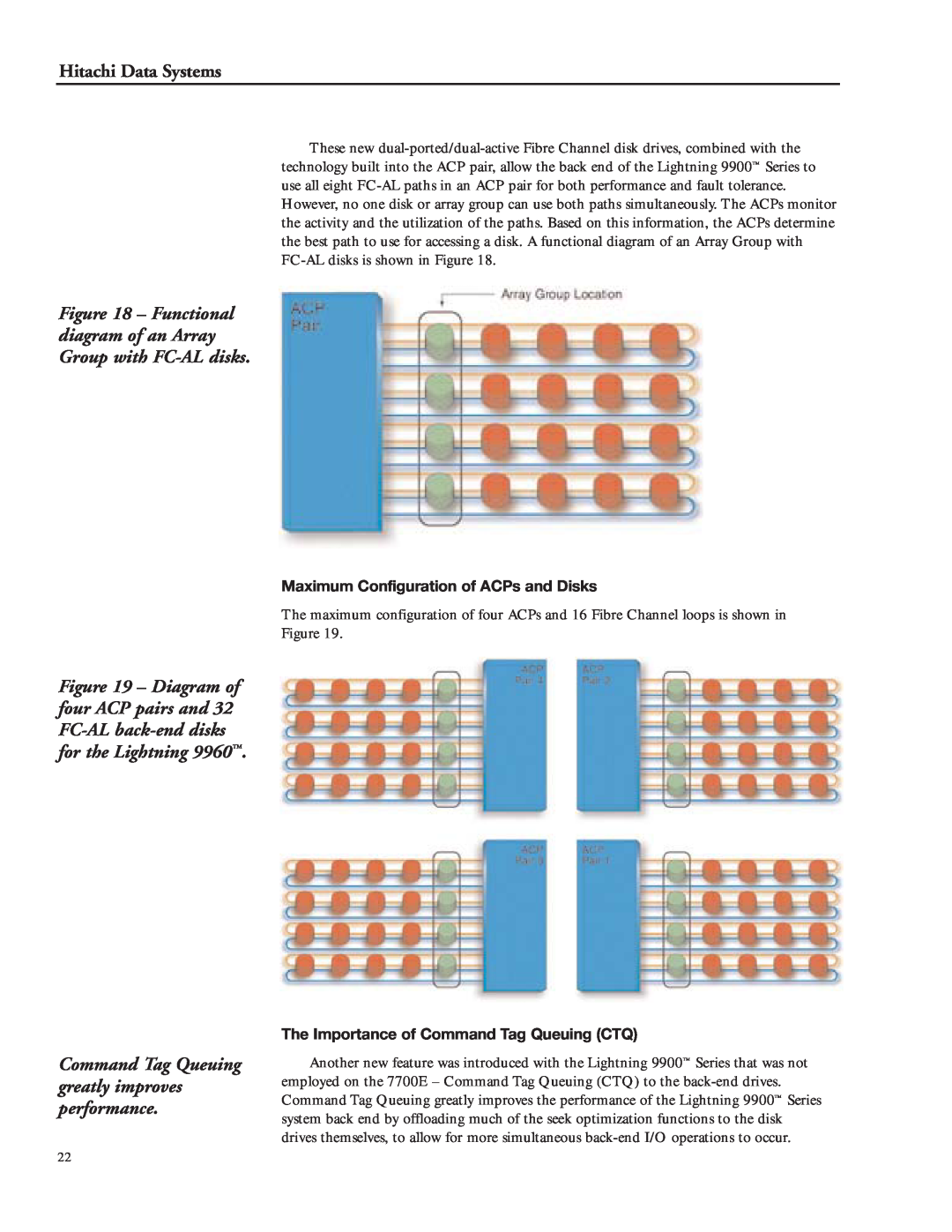Page
Page
Hitachi Data Systems
Table of Contents
Read-aheadfor High-performanceSequential Reads
Hitachi Data Systems
Remote Copy
Hitachi Data Systems
Hitachi NanoCopy Implementation Service
Table of Figures
Hitachi Data Systems
Tables
The most advanced design in storage
Introduction
Lightning 9900 Series Product Offerings
Hitachi Data Systems
The most powerful storage system in the world
Introduction
Mirrored cache instead of single image cache.1
Hitachi Data Systems
Introduction
Hitachi Data Systems
Model 9960 Control Frame
The Lightning 9900 Series
Packaging
Model 9960 Packaging
Model 9960 Array Frames
Hitachi Data Systems
Model 9910 Packaging
The Lightning 9900 Series Packaging
Figure 7 – A 9910 single-cabinetstorage subsystem
Hitachi Data Systems
Hitachi Lightning
Front-endDesign of the
Series
About the Fibre Channel Interface Boards
Hitachi Data Systems
Page
Bandwidth of Supported Host Interfaces
Hitachi Data Systems
Number of Host Interfaces Supported
The Internal Hi-StarArchitecture
Internal Switched
Hi-StarArchitecture – An
Hierarchical Star Network
Architecture
Hitachi Data Systems
Page
Control Memory Hierarchical Star Network
Hitachi Data Systems
The 9960 Provides 32GB of Fully Addressable Cache
Read-aheadfor High-performanceSequential Reads
Page
Hitachi Data Systems
High-speed Back-endDesign
High Performance Back-endDesign
New Fibre Channel Disk Drives
Hitachi Data Systems
Command Tag Queuing greatly improves performance
Maximum Configuration of ACPs and Disks
The Importance of Command Tag Queuing CTQ
RAID-5- Distributed Parity
Capacities and RAID Architecture
Storage Capacity of the Lightning 9900 Series
RAID-1+
High-densityDisk Drive Assemblies HDDs
Hitachi Data Systems
Hitachi High-Availability Software Improves
Application Service Levels
Open Systems High-AvailabilityMiddleware Support
Hitachi Data Systems
3.Host Failover
Hitachi Data Systems
Standard Hot-swapand Redundant Power Supplies
4.Parallel Database Clustering
Unmatched Competitive Advantage in RAID Choices
Standard Redundant Fans for Cooling
Hitachi Data Systems
Truly Scalable Performance
Performance Considerations
Test Results
Hitachi Data Systems
The Lightning 9900 Series
Software Solutions Are the
Best in the World
Software Solutions for the
Hitachi Data Systems
Figure 24 – Hitachi Data Systems offers a broad range of remote copy, data duplication, and data migration software solutions
PiT Copy
Remote Copy
Data Migration
Hitachi Data Systems
and warehousing
A powerful and open systems management philosophy
Centralized and Open
Systems Management
Software Simplifies IT Operations
Hitachi Data Systems
HiCommand is an important Hitachi management tool in that it provides a comprehensive storage management software framework that enables an enterprise to manage all supported Hitachi storage products and many Hitachi software solutions
The components of HiCommand
Deployment Management
Service Level Management
Hitachi Data Systems
Hitachi Resource Manager
Hitachi LUN Manager is an open systems management utility. With Hitachi LUN Manager, open systems Logical Units LUNs can be defined, configured, and maintained. There is no more waiting for the hardware vendor to come and make configuration changes. Hitachi LUN Manager includes an easy-to-use, GUI-basedinterface that allows the easy definition of paths for LUNs, the reconfiguration of LUN-to-portassignments, or the viewing of the Lightning 9900 remote service information messages. Because the Hitachi LUN Manager can assign multiple paths to a single LUN, support of alternate path failover, path load balancing, and clustered systems is possible. Running on a standard Windows-basedPC connected to the storage subsystems by a dedicated LAN, Hitachi LUN Manager can support up to eight Lightning 9900 systems
Hitachi CruiseControl
Hitachi Data Systems
Hitachi SANtinel
Storage Maximizer
Hitachi Data Systems
Cost of Risk Analysis methodology CORA
Professional Services and Support
Professional Services Overview
Data Protection Services
Hitachi Data Systems
Data Protection Services Lab
Remote Copy Assessment and Implementation Service
Hitachi NanoCopy Implementation Service
SAN services
Professional Services and Support
Continuous Availability Service
On-lineData Migration Service
Hitachi Data Systems
Software Portfolio Review and Analysis Service
the Performance Experiment
System Configurations for
The 7700E used all 6GB drives
Hitachi Data Systems
ACP pair
Glossary of Terms
10BaseT
100BaseT
Business Continuity Planning BCP
Hitachi Data Systems
Availability
Back end
CHIP
Glossary
CARB
Cache
CORA Cost of Risk Analysis
Hitachi Data Systems
Consistency Groups
Control Frame
Data Migration
Disaster Recovery
Glossary
Data Duplication
ESA/390
Hitachi Data Systems
EBCDIC
Electronic vaulting
Fast write
Glossary
Failover
Fast Ethernet
Front End
File Backup
Hitachi Data Systems
FICON
Hitachi CruiseControl
Hitachi FlashAccess
Glossary
HDmS
Hitachi LUN Manager
Hitachi Multiplatform Backup/Restore
Hitachi Data Systems
Hitachi InstantSplit
Hitachi SANtinel
Hitachi Rapid Recovery
Glossary
Hitachi Resource Manager
Java
Hitachi Data Systems
HXRC Hitachi Extended Remote Copy
HYPERtape
Logical Unit
Logical Volume
Glossary
Lightning 9900 Series
Meta-data
Hitachi Data Systems
MBCP
MIPS
NanoCopy
Glossary
MTBF
MTTR
Operating System
Hitachi Data Systems
On-linesystem
Open system
RAID Controllers
Recovery Time
Glossary
RAID
Snapshot
Switch
Hitachi Data Systems
SCSI
Synchronous
Virtual Logical Volume Image Manager
Volume
Glossary
Warm site
Hitachi Data Systems
Workload
Australia/New Zealand Headquarters
Hitachi Data Systems Worldwide Offices
Corporate Headquarters
Asia Headquarters
